 username@email.com
username@email.com
In this lesson, we will review genetics, Mendel’s principles and rules of inheritance, phenotypes and genotypes, pedigrees, genetic diseases, and non-lethal abnormalities.
In the lessons preceding this one, we reviewed the biochemical basis of life, the organic molecules, and their functions for living organisms. We also covered the basics of respiration, photosynthesis, and movement within and between cells.
After Van Leeuwenhoek discovered sperm cells in 1677, biologists were divided into two warring camps. The “ovists” insisted that it was the egg that carried the traits of the offspring, like an adult in miniature. The “spermists” insisted with equal vehemence that the complete future offspring was contained in the animalcule, or the sperm.
And so it went, until the mid-nineteenth century yielded the concept of blended inheritance, which suggested that the offspring’s traits arise from a complete blending of all the information in both gametes, or sex cells. In this view, making babies was akin to mixing different color paints — if Dad is red and Mom is white, the kids will all be pink.
An Austrian monk named Gregor Mendel realized the fallacy in this concept simply by noticing that all offspring were not, in a sense, pink. Traits skipped generations; offspring sometimes seemed to resemble neither parent. These anomalies intrigued Mendel and he used his position as monastery gardener to attempt to figure out what was really going on with inherited traits.
Mendel made the very fortuitous decision to conduct his experiments with common garden peas. He recognized that certain pea varieties seemed to be “pure” for specific characteristics; that is, their offspring always expressed these traits. Furthermore, pea traits were easy to observe. Mendel studied pea plant height (stem length), seed form, seed color, flower color, and other characteristics.
Mendel was not the first to notice or experiment with pea plant traits. He was, however, the first to study them for several generations, and to set up a rigorous scientific process to organize his methods and data. Additionally, he also made accurate counts of the number of plants with given traits he found in each generation and he analyzed his results mathematically. Perhaps Mendel’s greatest achievement, however, was the synergy of these. He was the first scientist to apply mathematical analysis to a biological problem concerning inheritance, and that is his claim to fame.
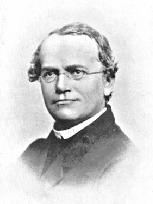
Mendel worked with 32 different types of pea plants with different physical characteristics. Mendel cross-bred pea plants with different traits by hand, pollinating the flowers from one strain with the pollen from another, so that he knew exactly which plants were the parents for every cross. He found that in the first generation of offspring (F1), one trait was expressed in all offspring and one trait completely disappeared. Mendel termed the traits that always appeared in the F1 generation dominant traits because they masked, or dominated, the traits that did not show up at all.
Mendel let the pea plants self-pollinate to produce the F2 generation. The traits absent from F1 were present in some plants of the F2 generation. Mendel understood that for these traits to appear in F2, they must have been present in F1, even if they were not expressed, or observable. Mendel called these traits recessive.
Mendel determined that the ratio of dominant-to-recessive traits in F2 was approximately 3:1, and this ratio held constant over generations. Mendel’s great insight was that each trait is caused by what he called “factors” (what we now call genes). These factors had to occur in pairs, one from each parent, for traits to appear, disappear, and reappear over generations. Mendel’s principle of segregation states that every organism contains a pair of factors for each trait and that the pairs segregate into single-factor units during the formation of gametes.
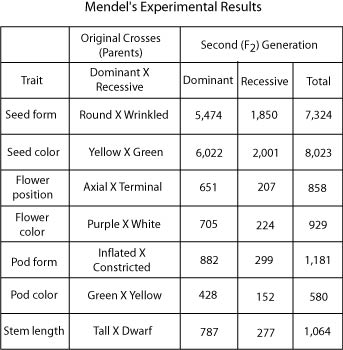
Today, we call the alternate forms of the same gene (Mendel’s “factor”) alleles. When alleles for a trait are the same, the individual is said to be homozygous for that trait. When the individual inherits two different forms of a specific allele (e.g., Aa), it is said to be heterozygous for that trait. Thus, pure-bred pea plants were homozygous for a given trait, creating smooth seeds, for example. All the seeds that these plants produced were visibly smooth. The visible, or expressed, trait is an organism’s phenotype. Had some of the pea plants been heterozygous for this trait, they too would have visibly smooth seeds. Yet despite this phenotype, some of these pea plants would have alleles for wrinkled seeds, even though this recessive trait was not expressed. An organism’s genotype describes its complete genetic makeup, or all its alleles, even those that are not expressed. Mendel had discovered that the unexpressed part of the genotype would be expressed in the phenotype of some offspring in the F2 generation.
The alleles an individual carries are part of the individual’s
The correct choice is B. An individual’s genotype describes its entire genetic makeup, including all its alleles. Phenotype refers to those traits that are physically expressed and visible in the individual. Because not all alleles are visibly expressed, choice A is not correct. Gametes are sex cells, so choice C is incorrect. Alleles are made up of DNA; they are not a part of it, so choice D is not correct.
Which of the following indicates an individual that is heterozygous for two traits?
The correct choice is C. This individual carries both dominant (A, B) and recessive (a, b) alleles for each trait. Choice A is incorrect because this individual carries pairs of identical dominant alleles for each trait. Choice B is not correct because this genotype indicates that the individual is homozygous (BB) for one trait. Choice D is incorrect because this individual, too, is homozygous recessive (aa) for one trait.
Mendel did another set of experiments to look at two traits in cross-bred pea plants. For example, in his first experiments Mendel noted that some plants had green, wrinkled seeds—both recessive traits. But the F2 generation also produced plants whose phenotype was totally unlike either parent: for example, offspring with smooth, yellow seeds. Mendel wanted to find out where these odd combinations of traits originated.
A Punnett Square allows you to sort and visualize the distribution of alleles in any cross. Capital letters indicate dominance and lowercase letters denote recessive alleles.
A P1 (Parent) generation has the trait smooth seed allele (S) or wrinkled seed allele (s). The alleles segregate and recombine during gamete formation. So offspring would have one of the following allele combinations for this trait.
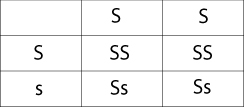
In this cross all the offspring express the dominant trait of smooth seeds.
Then, in the second generation (F2), some heterozygous individuals would be crossed. The Punnett Square for this cross is:
.jpg)
The Punnett Square below shows the sorting of alleles that determine hair color, with B indicating dominant brown hair and b indicating recessive red hair. What is the probability that an offspring of this cross will have red hair?
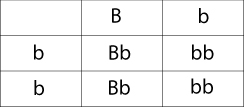
The correct choice is B. Two of the four possible crosses will be homozygous for the recessive trait, red hair. Choice A is not correct because half the offspring will have brown hair (Bb). Choice C is not correct because there are not three possible combinations that are the same. Choice D is incorrect because half the offspring are genetically different from the other half.
Mendel crossed a pure-bred dominant strain (round, yellow seeds) with a pure recessive strain (wrinkled, green seeds). In the F1 generation, all the seeds were round and yellow because the dominant trait was expressed. In the F2 generation, Mendel’s results were quite different, though he had correctly predicted them. Mendel used mathematical probability to determine that if his “factors” (alleles) sorted independently of one another, they should be expressed in the phenotype of offspring in a ratio of 9:3:3:1. The 9 represents the number of F2 offspring expressing the two dominant traits in its phenotype. The 1 represents the proportion of offspring that express the recessive phenotype (having two alleles for the recessive form of the trait). The two 3s represent individuals that show combinations of recessive and dominant traits in their phenotype. (This ratio holds for crosses in which both parents are homozygous—one for dominant traits and the other for recessive traits.) From these results, Mendel formulated his second law. The law of independent assortment states that the parts of each pair of genes are distributed independently when gametes are formed. Today, we can restate this to say that if an individual is heterozygous for traits that occur at two unlinked loci on chromosomes, each locus will sort independent of the other.
In F1, Mendel crossed pea plants that were homozygous dominant for smooth (SS), yellow (YY) seeds with plants that were homozygous recessive for green (ss), wrinkled (yy) seeds.
The first cross was: SSYY x ssyy → all SsYy. The F1 generation all expressed the dominant genes (all were smooth and yellow).
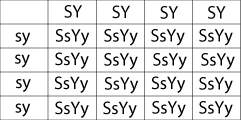
The F2 generation was allowed to self-pollinate. All the genes — S, s, Y, y — sorted independently to form gametes. All the possible gamete combinations are shown in the Punnett Square below.
.jpg)
An analysis of these results shows that:
The ratio is 9:3:3:1, just as Mendel predicted.